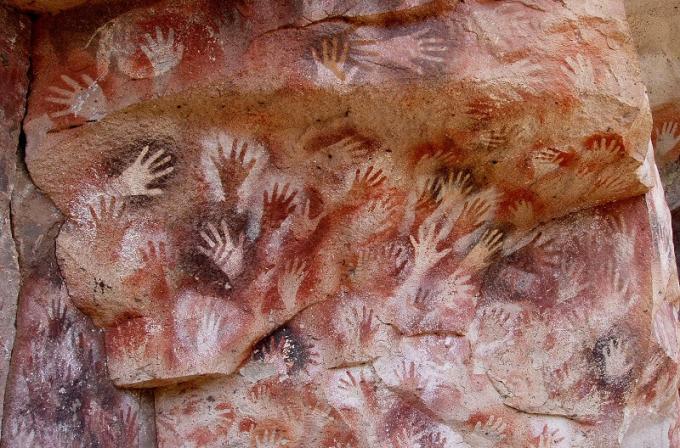First settlers of America: who were they, and how and when did they arrive?
When was America first populated? This has been a question whose answer is still a matter of debate, although there is not little evidence archaeological sites that indicate that the first settlers of America did not come at once or colonize the entire continent.
There are several theories about who were the first to set foot on the American continent, when they did and how they expanded. For having, there is even the theory that maintains that, similar to how it happened in Europe with the Neanderthals, there was some type of hominid miscegenation.
Whichever theory is preferred, today we are going to talk about the debate around who were the first settlers of America and what dates are proposed as the first moments in which that great territory was inhabited, which seems to have been gaining the nickname of being the New World since ancient times.
- Related article: "The 6 stages of Prehistory"
Who were the first settlers of America?
Understanding who the first settlers of America were and how they got there is a topic that has sparked a wide and arduous debate in the international scientific community. There are several theories that have been put forward to explain how the American continent was populated, when it happened and in what way.
There are those who believe that it was about 15,000 years ago and others much earlier, almost 40,000 years ago.One of the most widely shared and famous theories is that the first humans set foot in America around 20,000 years ago, through the Bering Strait, from Asia. Others, on the other hand, consider that this does not explain how the south of the continent could be inhabited so quickly after such event and that, in fact, everything indicates that there were already people living in South America, coming from Polynesia and Australasia.
- You may be interested in: "This is how the 4 main Mesoamerican cultures were"
The hypotheses on the occupation of America
The human beings who first set foot on the American continent are considered the ancestors of the famous Inca, Mayan, Aztec and Native American cultures of the United States and Canada, among others ethnicities. Nevertheless, The moment in which they set foot on the continent is something that has always aroused great debate and that has required a lot of scientific effort to be able to elucidate how the first colonization occurred. of the continent.
Native mythology, while rich and fascinating, does not make things very clear for us. For example, if we ask the Navajo culture, they argue that the first men arose from the land, that his people have lived there forever and that never, ever, have they been able to come from out of. They, and other Amerindian tribes, believe in their respective worldviews that their lineages date back to the creation of the Earth and that it was precisely that continent where they had to live, that from there they have not moved.

This belief that they come from the land is proof of how ancient their cultures are, that they no longer remember where they came from but attribute that they were always there. But, of course, it is not like that, from somewhere they had to come, and archeology, paleontology and population genetics have provided proof of the origins of the different pre-Columbian ethnic groups.
Based on the different findings made on the continent, three main theories have been considered that would explain how human beings first arrived in America.
Isolationist or evolutionary position
This theory proposes that, in one way or another, American civilizations originated on the continent itself as a result of the evolution of hominids that were there. That is, before the Homo sapiens, on the continent there were already other hominids and that, evolving and hybridizing with humans more modern, were creating human cultures of unique lineages, something similar to what happened in Europe with the Neanderthals.
The defenders of these theories, of the most controversial, use as proofs of these hypotheses the cultivation of cassava, corn, potatoes, quinoa, chili peppers and cocoa, plants unknown in other continents.
Among the main representatives of this theory we find the Argentine paleontologist Florentino Ameghino (1853-1911) and Charles Étienne Brasseur de Bourbourg (1814-1874). These ideas had some acceptance in the scientific community, as fossil remains of hominids have been found that do not belong to the species. Homo sapiens, more than 130,000 years old.
- Related article: "Anthropology: what is it and what is the history of this scientific discipline"
Diffusionist positions
The diffusionist positions mainly argue that Paleolithic cultures came to America through the Bering Strait, between the Russian autonomous district of Chukotka and the US state of Alaska. The first proper Americans used as a bridge the ice route that had been created between Siberia and North America, formed from the last ice age.
Within this position are also the theories that hold that human beings came from Polynesia. These contingent waves of humans were distributed across the continent for hundreds of years. According to the theory, They would be humans from regions such as Oceania, Europe and Asia, something that would explain certain genetic characteristics of some groups of Native Americans that still remain.
- You may be interested in: "Diffusionism: what it is, and characteristics of this anthropological school"
Eclectic position
Finally we find a more eclectic position, in which approaches of the two positions previously exposed are combined. This considers that there are certain cultural traits that are autochthonous to America but that, also, there had to be some kind of influence from abroad, contributions from other cultures that, by merging with the humans who lived there, created their own Amerindian.
Multiple migration theories
For a long time it was believed that the first settlers of America were the culture of Clovis, the name given to the human group from Asia that had crossed the Bering Strait and reached North America. This culture would have first set foot in the current United States and Canada at the earliest about 20,000 years ago, date to which North American scholars claimed was the earliest time that the continent had been populated American.
However, while this would be true for North America, it could not be extrapolated to the rest of the continent. Findings from other places further south confirm that there were human beings before those 20,000 years, and there are those who believe that there could have been human activity about 40,000 years ago. Genetics also denies the idea that they reached North America and that from there they spread to the rest of the continent.
There is a marked uncoupling between the native cultures of North and South America, evidenced in linguistic, geographical and even genetic differences, a fact that confirms that American peoples prior to the arrival of Europeans were the result of different migrations. In Peru, for example, genetic lineages of Polynesian origin have been found. Thus, many scientists consider that the American continent was originally populated in several batches, a theory which is called the multiple migration theory.
In Brazil, for example, objects from more than 30,000 years ago have been found; in Venezuela, tools from 14,000 years ago; in Chile there are human remains of about 30,000 years old while in North America they only reach 10,000 and 12,000 years. That is, there appears to be evidence that, although the first settlers of the present United States and Canada did it crossing the Bering Strait, south of the continent, the first humans would have arrived there through other Steps, from the Pacific, Asia and Oceania. Discoveries in southern Mexico would confirm this idea.
In July 2020, a new discovery was made in the Mexican state of Zacatecas, in the Chiquihuite cave. What was found there suggests that humans inhabited the continent some 15,000 years earlier than previously believed, because thanks to radiocarbon techniques and optically stimulated luminescence, scientists were able to determine the age of the remains estimated at about 33,000 years. This confirms the idea that there were people in that place before the end of the Last Glacial Maximum (20,000 years ago).
- Related article: "The 23 auxiliary sciences of History (explained and classified)"
The skeleton of Chan Hol ll
One of the most important archaeological finds to determine when the first settlers of America lived we have it in the skeleton of Chan Hol II, in the Yucatan peninsula, Mexico.
The skeletal remains found date back to the late Pleistocene, during the last ice age. The team in charge of the discovery was led by Professor Dr. Wolfgang Stinnesbecl and biologist Arturo González González, dating the skeleton to at least 13,000 years ago based on a stalagmite that had grown from the bone of the hips.
The human fossils were discovered in a flooded cave system, near Tulum, Quintana Roo. After the first discovery in the area, more human remains were found, each one baptized with a characteristic appellative: The Woman of Naharon, The Woman of the Palms, The Man of the Temple, Naia and the skeleton of Chan Hol II.
According to scientists, this cave system was above sea level. However, following the global rise in sea levels at the end of the Ice Age, The caves remained under water, protecting in good condition the skeletal remains of ancestral inhabitants of the American continent, bones that have been of great scientific relevance. on the question of when and how the first settlers of America lived.


